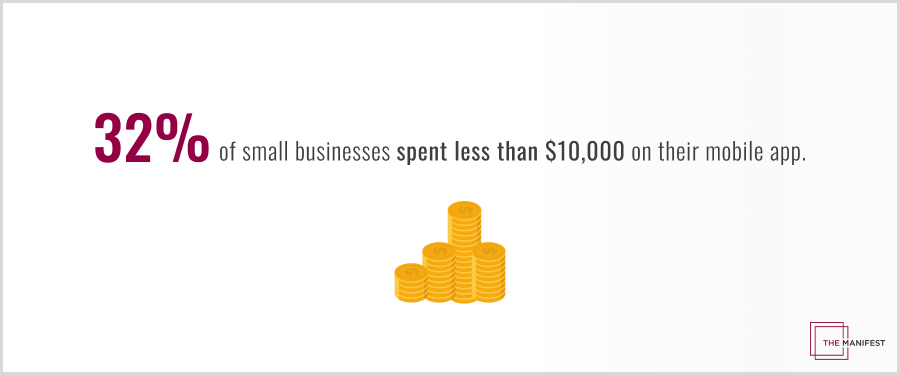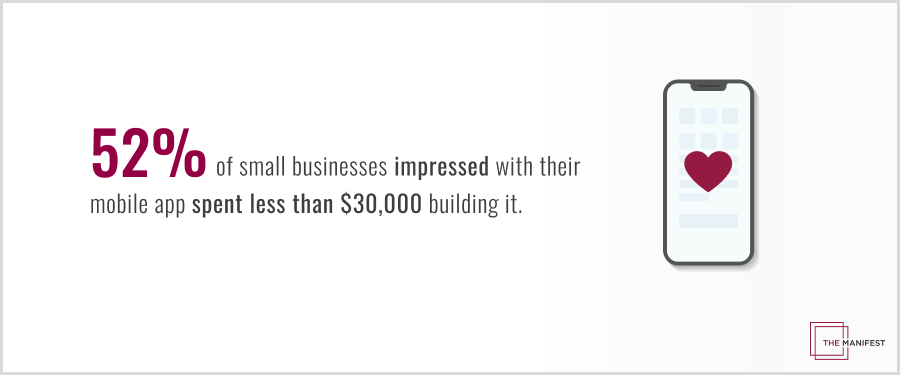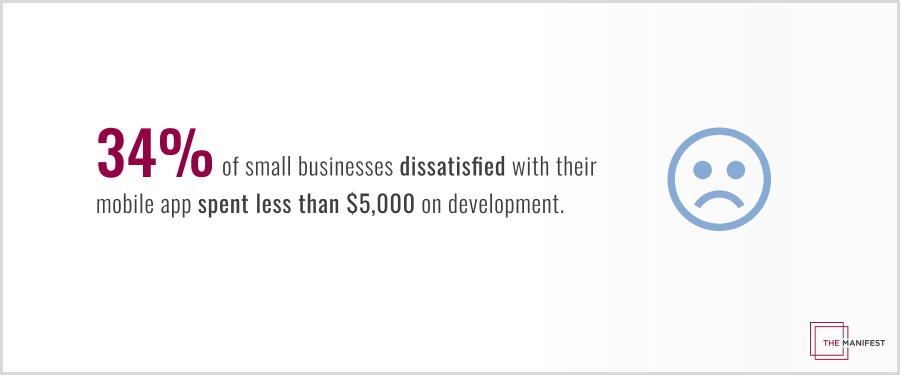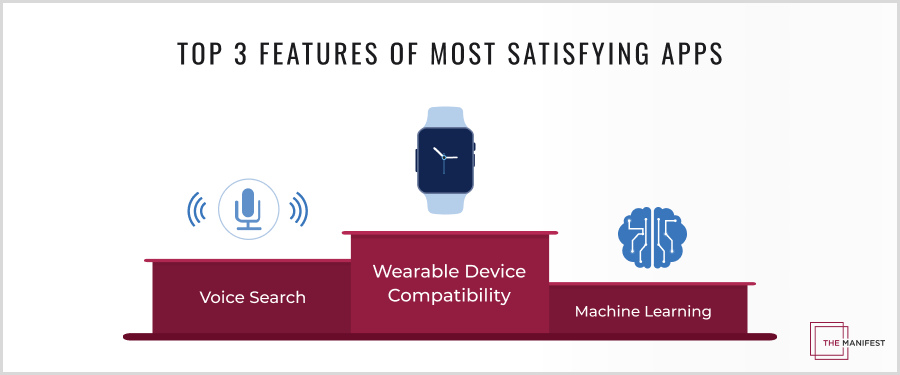2022 App Trends: How Much Does It Cost to Make an App?

2022 App Trends: How Much Does It Cost to Make an App?
It’s true that small businesses can create an app on almost any budget, but that doesn’t mean that the app will be very good. The Manifest surveyed 1,003 small business owners to determine how much money small businesses should invest in building an app in 2022.
Small business owners: do you think you overpaid for an app development project? Underpaid? Just how much should it cost to develop a quality app anyway?
For many, the answers to these questions aren’t clear. Ten different app development firms may provide ten vastly different quotes for the same project depending on a number of variables (to name a few: feature requirements, firm location, timeline).
Because of these variables, it can be challenging to evaluate app development pricing without past experience. Of course, determining the budget should be one of many steps in vetting an app development partner, but it’s a critical stage that directly impacts your success.
So, is there an ideal price range for an app development project that guarantees quality without breaking a small business budget?
The Manifest surveyed 1,003 small business owners and managers to learn about app development pricing. Using this data, we learned how much a small business should expect to pay for app development services that meet or exceed performance expectations in 2022.
Our Findings
- About a third of small businesses (32%) spend less than $10,000 creating their mobile app, showcasing that app dev can be executed on a budget.
- Over half of small businesses (52%) that are satisfied with the performance of their app spent less than $30,000 on development, implying that businesses don’t need to overspend to create a solution that meets their needs.
- One in three apps (34%) with reported quality issues were made for less than $5,000, highlighting the importance of investing in professional services.
- The most popular features in small business mobile apps are mobile payments (49%), multi-tasking (38%), voice search capabilities (35%), personalization features (35%), social and community components (32%), mCommerce (32%), and location-based services (31%). This indicates what small businesses perceive to be must-have mobile app features.
- The features that were most satisfying to small businesses were wearable device compatibility (92%), voice search (90%), and machine learning (89%), indicating that these features are commonly part of a successful app.
Are you planning to build a mobile app? Connect with a top mobile app development company today on The Manifest.
How Much Does It Cost to Make an App in 2022?
App development pricing can seem intimidating, especially for small businesses with limited resources.
The truth is that most small businesses with mobile apps recognize that they don’t need to spend a lot of money to get a basic app that meets their needs.
As of 2022, about one-third of small businesses (32%) developed their mobile app for less than $10,000.

What a business spends on app development is completely dependent on its needs. Some companies will choose to invest heavily in a strong user experience while others may be looking for places to cut costs.
Ian Sells is the founder and CEO of cost-savings service RebateKey, which launched its app in 2021. All requirements are different, so costs will vary, but Sells recommends that companies avoid cutting costs to the point of affecting quality.
“You don't want to compromise on the quality of your app because it defeats the purpose of having an app,” Sells said. “You want an app because you want your product or service to be more accessible for your users.”
Businesses aiming to cut costs have several options such as using open source code or outsourcing app development work to a more affordable firm.
Without a larger budget, some more cutting-edge functionality such as augmented reality (AR) features might not be available. However, many small businesses likely don’t need that level of tech to meet consumer needs with a mobile app.
Even with a budget of less than $10,000, more than a quarter of small businesses were able to obtain the following mobile app features:
- Mobile payments
- Multitasking
- Voice search
- Location-based features
- Chatbots
- Mobile shopping experiences (mCommerce)
- Personalization elements
- Community elements (likes, comments, shares)
Committing to a tight budget doesn’t mean that you can’t get quality work. Just make sure your features list is possible with the cash you have on hand to spend.
Especially for companies looking to use a mobile app to generate sales, these features are all many small businesses need.
How Much Should I Budget For App Development in 2022?
Businesses can develop an app on almost any budget, but not every app will be satisfying from a quality and performance perspective.
In the small business world, most small businesses start to feel reliably satisfied with app performance at around the $30,000 mark.
More than half of small businesses (52%) that are happy with their mobile app’s performance spent less than $30,000.

Between $10,000–$30,000, small businesses have the opportunity to include all the aforementioned mobile app features, likely at a higher quality. In addition, the following app features become more attainable:
- Wearable device compatibility
- Gamification
- Augmented reality
- Machine learning
Not all businesses will need high-tech features like AR and machine learning, but companies that expand budgets to invest may reap significant benefits. Especially as people are seeing more and more machine learning and algorithms in daily life, certain features could help some apps compete against larger competitors.
Gergo Vari is the CEO and founder of recruiting and talent acquisition platform Lensa. Vari sees the value in businesses working to achieve a balance between cost-effectiveness and high-quality functionality when creating an app.
“If a small business wants to compete with larger businesses in terms of features and quality, then it will need to expand its budget,” Vari said. “However, if a small business is looking to create a basic app that meets the needs of its customers, it may be able to get by with a smaller budget.”
“If a small business wants to compete with larger businesses in terms of features and quality, then it will need to expand its budget.”
Not all small businesses need to compete with huge companies. In those cases, a smaller budget works fine. However, it’s important that companies invest what they need in app development in order to produce a high-quality solution that meets customer needs.
Mobile App Quality Issues Stem From Budget Constraints
Budgets are important — especially to small businesses without the resources of large corporations.
Budgetary constraints may tempt companies to scale down the scope of their mobile app or accept the least expensive quote offered. Affordability is key, but this may have negative implications on the quality of the final product.
About one-third of the small businesses that were dissatisfied with the quality of their app spent less than $5,000 developing it.

Ending up with a low-quality product is just one of the dangers of investing too little in app development. Vari explains that there are two major downsides to skimping on app development: functional issues and design problems.
“The dangers of spending too little on developing a mobile app are twofold. First, if you cut too many corners during development, your app may have quality issues that frustrate users and cause them to delete your app,” Vari said. “Second, if your app is not well-designed or user-friendly, it may not be successful in attracting and retaining customers.”
“If you cut too many corners during development, your app may have quality issues that frustrate users and cause them to delete your app.”
Whether the issue with your app is functional or design-related, both types of problems will drive users away from your app and brand.
The last thing you want after investing time and money into an app is for people to dislike it. Poor apps can drive people further from your business, making it even more difficult to grow. Budgets are important, but small businesses shouldn’t sacrifice quality for cost-effectiveness when it comes to app development.
The Most Popular App Features Promote Purchases and Referrals
The main variable that determines the cost of creating a mobile app is the scope of work. If companies are looking for apps with all the latest bells and whistles, it’s going to cost more than a basic e-commerce app.
So, what make-or-break features are small businesses spending their money on? The most popular mobile app features among small businesses are those that promote purchases, referrals, and visibility.
Almost half of small businesses (49%) enabled mobile payments within their mobile app, making it the most popular app feature.

Vari notes that the most requested app features by small businesses are those that make it more approachable to customers.
“Many small businesses are focused on creating an app that is convenient and easy to use for their customers,” Vari said. “Mobile payments and multitasking are features that can make an app more convenient.”
Convenience and the facilitation of sales seem to be on most small business owners’ minds when requesting features for their app. Here are how some of the most popular app features are applied by users once an app is launched:
- Mobile payments: a customer completes a purchase on an e-commerce app by making a payment through Stripe or Paypal
- Multitasking: customers view and interact with several different windows and apps while the original app stays active and functioning
- Voice search: a customer activates a speech recognition software within the app to give a command or make a query
- Personalization features: a user customizes their profile or features within an app to make the experience most preferable themselves
- Comments, shares, reviews: users interact in comments, message boards, reviews, and more in-app while also having options to share app content with others outside the platform
Each feature is designed to make purchases and engagement accessible to users. The convenience of these features invites consumers onto mobile apps to make purchases and establish brand loyalty.
Small Businesses Are Most Satisfied With Features That Enhance User Experience
The most popular mobile app features aren’t necessarily going to be the most successful.
Small businesses that invested in-app features that sharpen user experience were more satisfied with their final product than those with promotional features alone.
The features that best satisfied small businesses in their apps were wearable compatibility (92%), voice search (90%), and machine learning (89%).

It’s important to note that these are some of the more costly features to add to an application and may not apply to small business needs.
However, experts believe that these features elevate an app in ways that exceed consumers’ baseline expectations. Phil Boyer, president and CEO of tax return company i2290, also notes that there’s an appeal in the cutting-edge nature of features like machine learning.
“Small businesses invest in payment and productivity features to keep up with baseline customer expectations and prevent customer attrition, but these are not the things customers rave about,” Boyer said. “Wearables, AI, AR, and VR are sexy and magical.”
“Wearables, AI, AR, and VR are sexy and magical.”
It’s true that high-tech features go far in capturing user attention and expanding the possible uses of a tool. Companies are aware of this intrigue too — they create advertisements that showcase the seemingly mystical qualities of tech.
Take wearables, for instance. In 2020, Apple launched a campaign called “The Device that Saved Me.” It consisted of a video that shared the near-death experiences of 5 Apple Watch owners.
The video highlighted the positive impact the wearable device had on user health, showcasing the product as a wellness necessity.
Top app features like mobile compatibility, voice search, and machine learning serve to heighten user experience and elicit a sense of wonder.
Mobile App Development Costs Requires Understanding Business Needs
Every small business’s needs will vary, determining the requirements for their mobile app development projects. So, how much does it cost to make an app? It truly depends on need.
However, small business app trends point toward companies not needing to spend enterprise-app prices to attain a solid product that works for their audience.
Underspending on app development endangers quality, but companies may not reap the expected benefits if they choose to increase spending without clear goals.
Small businesses should define the features they desire in their solution and then thoroughly vet several potential app development firms to get a true sense of the possibilities.
Working on your own app plans? Hire a top mobile app development company on The Manifest.
About The Survey
The Manifest surveyed 1,003 small business owners and managers at companies in the U.S. with fewer than 500 employees in December 2021. Fifty-seven percent (57%) of respondents are male; 43% are female. Thirty-six percent (36%) are 18 to 34; 53% are 35 to 54; 11% are 55 or over. Five percent (5%) of respondents’ businesses have one employee; 28% have 2 to 10 employees; 31% have 11 to 50 employees; 24% have 51 to 250 employees; 12% have 251 to 500 employees. Respondents are from the South (42%), West (21%), Midwest (20%), and Northeast (17%).
